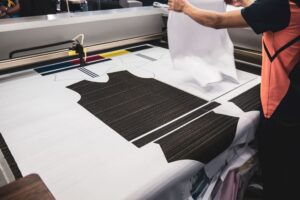In recent years, fashion has undergone a much-needed transformation. Once known for fast-paced production and environmental strain, the industry is now shifting toward more conscious choices. As environmental awareness grows, so does the demand for eco-friendly clothing material that aligns with both personal values and modern style.
More than a trend, this new wave of sustainable fashion is a movement. With innovations in textile development and increasing transparency in supply chains, environmentally friendly clothing materials are becoming the go-to choice for designers and consumers who want to wear their values.
Why Choose Eco-Friendly Fabrics?
Choosing eco-friendly fabrics is a tangible way for both brands and consumers to reduce environmental impact while still prioritizing comfort, performance, and design integrity. These thoughtfully developed materials combine sustainability with innovation, offering long-term benefits that go far beyond aesthetics.
Reduced Environmental Footprint
Most eco-friendly clothing material options require significantly less water, energy, and harmful chemicals during cultivation and production. This leads to lower pollution levels and conserves precious natural resources.
Improved Biodegradability
Natural and low-impact textiles like organic cotton or linen decompose faster than synthetic ones, reducing landfill buildup and supporting a more circular life cycle for fashion.
Support for Ethical Farming and Sourcing
Many of the best eco-friendly fabrics, such as hemp and organic cotton, are sourced from agricultural systems that prioritize soil health, fair labor practices, and biodiversity.
Lower Emissions Through Closed-Loop Systems
Certain environmentally friendly clothing materials, like TENCEL™ or recycled polyester, are made using advanced processes that minimize carbon output and maximize resource reuse.
Consumer Health Benefits
Because these fabrics are processed with fewer toxic substances, they help reduce skin irritations, allergies, and long-term exposure to harmful residues for both wearers and garment workers.
The Best Eco-Friendly Fabrics for Sustainable Clothing
Sustainability starts with smart material choices. Below are some of the best eco-friendly fabrics gaining traction in today’s fashion landscape—not just for their low impact, but for their versatility and appeal.
Organic Cotton
Grown without synthetic pesticides or fertilizers, organic cotton supports healthier soil and safer working conditions. It’s a breathable, soft, and durable material, perfect for everything from casual tees to babywear.
TENCEL™ Lyocell
Made from wood pulp sourced from responsibly managed forests, TENCEL™ is prized for its silky texture and moisture-wicking properties. This fiber is created using a closed-loop process that reuses water and solvents efficiently.
Hemp
Naturally pest-resistant and fast-growing, hemp is among the most sustainable crops available. As a textile, it’s strong, breathable, and becomes softer with each wash. This makes it a top contender in the world of eco-friendly clothing material.
Recycled Polyester
By repurposing plastic waste, recycled polyester helps reduce landfill overflow and dependence on fossil fuels. It offers the same durability and stretch as virgin polyester, but with a significantly smaller carbon footprint.
Linen
Produced from flax plants, linen requires less water and fewer chemicals compared to many other fibers. It’s light, breathable, and biodegradable, making it a timeless option for environmentally friendly clothing materials.
How Sustainable Brands Are Innovating
As sustainability becomes a defining force in fashion, brands are reimagining their approach to everything—from materials and design philosophies to the systems behind production. This shift is happening across the board, with both emerging labels and established companies leading the charge toward more responsible practices.
Here are some of the ways forward-thinking brands are integrating sustainability:
- Embracing zero-waste or minimal-waste cutting techniques
- Replacing synthetic dyes with plant-based or low-impact alternatives
- Offering garment recycling programs and upcycled collections
- Using digital tools to reduce overproduction and improve supply chain efficiency
Challenges in the Sustainable Fabric Movement
While the growing popularity of eco-friendly fabrics signals a positive shift in the fashion industry, the transition to sustainable practices is not without its complications. Both businesses and consumers continue to face barriers that can slow or complicate the adoption of environmentally friendly clothing materials.
Limited Accessibility
High-quality, eco-friendly clothing material isn’t always available at scale or in all regions. This makes it difficult for some brands to adopt sustainable alternatives consistently.
Higher Production Costs
Sourcing and producing eco-friendly fabrics often requires more ethical labor, better technology, and responsible farming practices—all of which can increase the final cost for manufacturers and consumers.
Greenwashing and Misleading Claims
Some brands may exaggerate or falsely claim sustainability in their marketing without making meaningful changes to their sourcing or production methods, which creates confusion and mistrust in the market.
Material Limitations in Performance or Versatility
Not all environmentally friendly clothing materials offer the same performance, stretch, or durability as their synthetic counterparts, which can limit their use in certain product categories.
Lack of Consumer Awareness and Transparency
Many consumers are still unsure about what truly defines eco-friendly clothing material. For companies, this highlights the need for better education, clearer labeling, and brand accountability.
Lead the Change in Sustainable Style
Looking ahead, the future of fashion lies in mindful choices—starting with materials. With an ever-growing range of best eco-friendly fabrics and more refined sustainable practices, the industry is on track for a meaningful transformation. By opting for conscious alternatives, fashion professionals and consumers alike play a vital role in reducing environmental harm and shaping a more responsible future.
At Hammax, we’re committed to supporting this evolution. Whether you’re launching a sustainable brand or transitioning to eco-friendly fabrics, our expert team is here to guide you. From sourcing to strategy, we can help you create stylish, durable, and responsible garments that reflect your values and meet tomorrow’s expectations.



